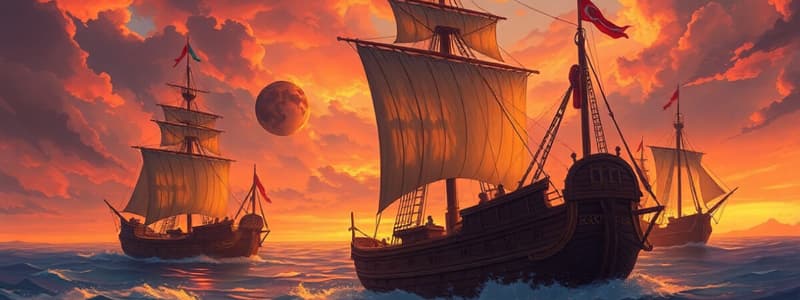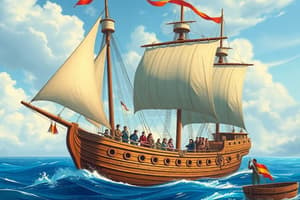Podcast
Questions and Answers
What misconception did many Europeans hold about the world 500 years ago?
What misconception did many Europeans hold about the world 500 years ago?
- The world was flat (correct)
- There were many undiscovered continents
- The world was spherical
- There was only one ocean
Which countries did Columbus approach for support before Spain?
Which countries did Columbus approach for support before Spain?
- Italy, Greece, and Portugal
- Spain, France, and the Netherlands
- Portugal, Venice, and Genoa (correct)
- France, Norway, and England
How long did Columbus's voyage across the Atlantic take?
How long did Columbus's voyage across the Atlantic take?
- 25 days
- 36 days (correct)
- 60 days
- 49 days
What did Columbus initially believe about the land he discovered?
What did Columbus initially believe about the land he discovered?
What fear prevented many European sailors from crossing the Atlantic Ocean?
What fear prevented many European sailors from crossing the Atlantic Ocean?
Which ships did Columbus take on his journey?
Which ships did Columbus take on his journey?
What was one of the primary motivations for Columbus's voyage?
What was one of the primary motivations for Columbus's voyage?
Which of these challenges did Columbus face during his voyage?
Which of these challenges did Columbus face during his voyage?
Why are Native Americans sometimes referred to as 'Indians'?
Why are Native Americans sometimes referred to as 'Indians'?
What method did Columbus use to persuade patrons for his voyage?
What method did Columbus use to persuade patrons for his voyage?
Flashcards
Voyage
Voyage
The act of traveling across a large body of water, especially by ship.
Patron
Patron
A person who pays for or supports a project or enterprise.
Explorer
Explorer
A person who explores unknown or unfamiliar regions.
Cartographer
Cartographer
Signup and view all the flashcards
Flat Earth Theory
Flat Earth Theory
Signup and view all the flashcards
Sea Monster
Sea Monster
Signup and view all the flashcards
Native Americans
Native Americans
Signup and view all the flashcards
Caribbean Islands
Caribbean Islands
Signup and view all the flashcards
The Americas
The Americas
Signup and view all the flashcards
The Niña, the Pinta, and the Santa Maria
The Niña, the Pinta, and the Santa Maria
Signup and view all the flashcards
Study Notes
Christopher Columbus's Voyage
- Columbus sailed from Europe to North America in 1492, a pivotal event connecting Europeans and Native Americans.
- He sailed from Europe to Asia, believing the world was smaller and that only three continents existed (Europe, Asia & Africa).
- Columbus used maps and math to support his westward voyage.
- He faced skepticism, requiring financial backing from royalty (Portugal, Venice, Genoa, & Spain).
- His voyage involved three ships: the Niña, Pinta, and Santa Maria.
- The 36-day journey across the Atlantic initially worried his crew due to the uncertainty, but they eventually landed on an island in the Caribbean.
Columbus's Misconceptions
- Columbus believed he'd reached Asia, not realizing he had discovered a new continent.
- This misunderstanding led to the term "Indians" for Native Americans.
- His beliefs were based on pre-existing European understanding of geography (and a belief that the world was flat).
- Concerns over sea monsters and potential dangers also contributed to the opposition to his journey.
Impact of the Voyage
- Columbus wasn't alone in his voyage - he traversed the Atlantic four times.
- Spain gained a vast empire in North and South America as a consequence in addition to valuable resources/land.
- Columbus's actions profoundly impacted the world by connecting two different civilizations.
Studying That Suits You
Use AI to generate personalized quizzes and flashcards to suit your learning preferences.




